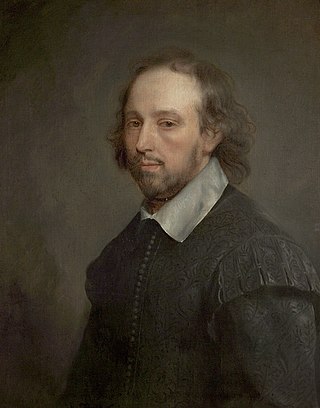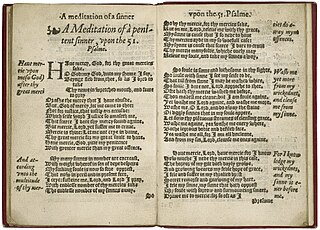Related Research Articles

A sonnet is a poetic form that originated in the poetry composed at the Court of the Holy Roman Emperor Frederick II in the Sicilian city of Palermo. The 13th-century poet and notary Giacomo da Lentini is credited with the sonnet's invention, and the Sicilian School of poets who surrounded him then spread the form to the mainland. The earliest sonnets, however, no longer survive in the original Sicilian language, but only after being translated into Tuscan dialect.
A tercet is composed of three lines of poetry, forming a stanza or a complete poem.

Sir Thomas Wyatt was a 16th-century English politician, ambassador, and lyric poet credited with introducing the sonnet to English literature. He was born at Allington Castle near Maidstone in Kent, though the family was originally from Yorkshire. His family adopted the Lancastrian side in the Wars of the Roses. His mother was Anne Skinner, and his father Henry, who had earlier been imprisoned and tortured by Richard III, had been a Privy Councillor of Henry VII and remained a trusted adviser when Henry VIII ascended the throne in 1509.
A rhyme scheme is the pattern of rhymes at the end of each line of a poem or song. It is usually referred to by using letters to indicate which lines rhyme; lines designated with the same letter all rhyme with each other.
An octave is a verse form consisting of eight lines of iambic pentameter or of hendecasyllables. The most common rhyme scheme for an octave is ABBA ABBA.
A sestet is six lines of poetry forming a stanza or complete poem. A sestet is also the name given to the second division of an Italian sonnet, which must consist of an octave, of eight lines, succeeded by a sestet, of six lines.

Elizabethan literature refers to bodies of work produced during the reign of Queen Elizabeth I (1558–1603), and is one of the most splendid ages of English literature. In addition to drama and the theatre, it saw a flowering of poetry, with new forms like the sonnet, the Spenserian stanza, and dramatic blank verse, as well as prose, including historical chronicles, pamphlets, and the first English novels. Major writers include William Shakespeare, Edmund Spenser, Christopher Marlowe, Richard Hooker, Ben Jonson, Philip Sidney and Thomas Kyd.
This is a glossary of poetry terms.

Sonnet 1 is one of 154 sonnets written by the English playwright and poet William Shakespeare. It is a procreation sonnet within the Fair Youth sequence.

Sonnet 130 is a sonnet by William Shakespeare, published in 1609 as one of his 154 sonnets. It mocks the conventions of the showy and flowery courtly sonnets in its realistic portrayal of his mistress.

Sonnet 30 is one of the 154 sonnets written by the English poet and playwright William Shakespeare. It was published in the Quarto in 1609. It is also part of the Fair Youth portion of the Shakespeare Sonnet collection where he writes about his affection for an unknown young man. While it is not known exactly when Sonnet 30 was written, most scholars agree that it was written between 1595 and 1600. It is written in Shakespearean form, comprising fourteen lines of iambic pentameter, divided into three quatrains and a couplet.

Sonnet 12 is one of 154 sonnets written by the English playwright and poet William Shakespeare. It is a procreation sonnet within the Fair Youth sequence.
The volta, or turn, is a rhetorical shift or dramatic change in thought and/or emotion. Turns are seen in all types of written poetry. In the last two decades, the volta has become conventionally used as a word for this, stemming supposedly from technique specific mostly to sonnets. Volta is not, in fact, a term used by many earlier critics when they address the idea of a turn in a poem, and they usually are not discussing the sonnet form. It is a common Italian word more often used of the idea of a time or an occasion than a turnabout or swerve.

The sonnets of Petrarch and Shakespeare represent, in the history of this major poetic form, the two most significant developments in terms of technical consolidation—by renovating the inherited material—and artistic expressiveness—by covering a wide range of subjects in an equally wide range of tones. Both writers cemented the sonnet's enduring appeal by demonstrating its flexibility and lyrical potency through the exceptional quality of their poems.

Sonnet 78 is one of 154 sonnets published by the English playwright and poet William Shakespeare in 1609. It is one of the Fair Youth sequence, and the first of the mini-sequence known as the Rival Poet sonnets, thought to be composed some time from 1598 to 1600.
"The World Is Too Much with Us" is a sonnet by the English Romantic poet William Wordsworth. In it, Wordsworth criticises the world of the First Industrial Revolution for being absorbed in materialism and distancing itself from nature. Composed circa 1802, the poem was first published in Poems, in Two Volumes (1807).

Anne Locke was an English poet, translator and Calvinist religious figure. She has been called the first English author to publish a sonnet sequence, A Meditation of a Penitent Sinner (1560), although authorship of that work has arguably been attributed to Thomas Norton.

The sonnet was a popular form of poetry during the Romantic period: William Wordsworth wrote 523, John Keats 67, Samuel Taylor Coleridge 48, and Percy Bysshe Shelley 18. But in the opinion of Lord Byron sonnets were “the most puling, petrifying, stupidly platonic compositions”, at least as a vehicle for love poetry, and he wrote no more than five.
Love Is Not All: It Is Not Meat nor Drink is a 1931 poem by Edna St. Vincent Millay, written during the Great Depression.
"Reuben Bright" is a (modified) Petrarchan sonnet written by American poet Edwin Arlington Robinson, early in his career, and published in Children of the Night (1897). The poem acquired some fame as teaching material for English teachers.
References
- Lever, J.W. The Elizabethan Love Sonnet. London: Barnes & Noble, 1968.
- Miller, Nelson. "Basic Sonnet Forms". Retrieved 3 January 2011.
- Spiller, Michael R. G. The Development of the Sonnet: An Introduction. London: Routledge, 1992. Web. 5 Dec. 2013.